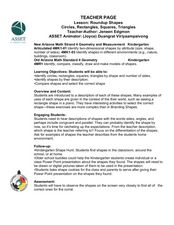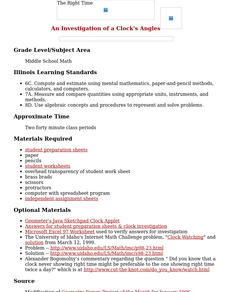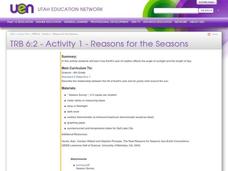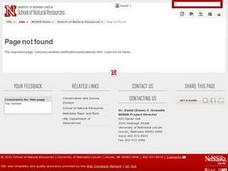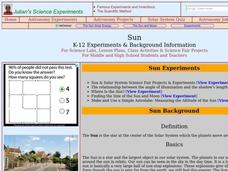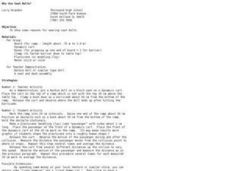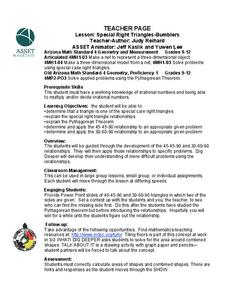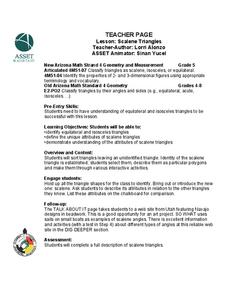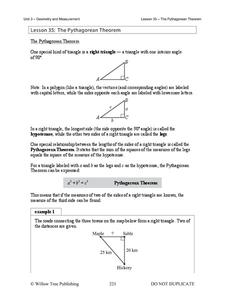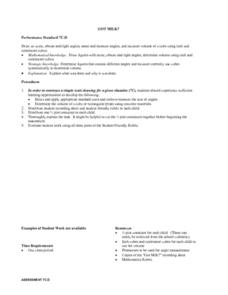Curated OER
Circles, Rectangles, Squares, Triangles
Students identify, compare and classify the various shapes. In this shapes lesson plan, students listen to descriptions of shapes with words such as sides, angles, congruent, and parallel. Students then give the teacher examples of...
Curated OER
Drawing Regular Polygons
Learners investigate properties of regular polygons. In this geometry lesson, your class will use a graphing calculator and parametric equations to construct regular polygons and investigate the relationship between the measure of...
Curated OER
The Right Time
Students compute and estimate using mental mathematics, paper-and-pencil methods, calculators, and computers. They measure and compare quantities using appropriate units, instruments and methods. They utilize worksheets imbedded in this...
Curated OER
Reasons for the Seasons
Sixth graders conduct and analyze a survey that explores public perceptions about the reasons for seasonal change. They measure the changing length of days, observe shadows and discuss how the Earth's axis of rotation affects the seasons.
Curated OER
Earth's Atmosphere and Temperature
Students explore the layers of earth's atmosphere and conduct an experiment to identify carbon dioxide. They construct models using styrofoam to represent molecules in the atmosphere's layers. To discover how sunlight efffects...
Curated OER
Surveying: 19 Chains and 50 Links
Through an interdisciplinary lesson, emerging engineers explore the history of surveying systems. After discussing various systems, they perform surveys on printable pages. Using their geometric skills, they physically stake out plots...
Curated OER
Sun
Students study how the sun is at the center of the solar system. In this solar lesson students measure the altitude of the sun and its size.
Curated OER
Plenty of Pythagoras
Using a twelve foot knotted rope, students form a 3-4-5 right triangle. Following a discussion of observations about the lengths of the sides of the triangle, students use grid paper, scissors and a centimeter ruler to draw and measure...
Curated OER
Why Use Seat Belts?
Students explore reasons why using a seat belt is a safe choice while riding in a car. In this physics/safety lesson, students set up and observe a doll with and without a seat belt moving down a ramp in a dynamics cart. Collision...
Curated OER
Water and Ice: Part 1
Students observe the state changes in water. In this matter lesson, students observe, measure, and describe water as it changes state. Students explore how water can change from a solid to a liquid then back again. They journal their...
Curated OER
Math All Around Us!
Students find math concepts in every day items. In this math concept lesson, students take ten photographs of things they find interesting. They analyze the photographs to find hidden math concepts such as counting, lines, angles,...
Curated OER
Tropical Atlantic Aerosols
Students analyze NASA data from the Multi-angle Imaging Spectroradiometer. In this NASA data lesson, students access an assigned website to examine information from the MISR on the Terra Satellite. They determine how desert dust travels...
Curated OER
Glacial Landscapes
Students examine the impact of glaciers on Great Britain. In this geological history lesson plan, students examine and measure a glacial valley and look at several types of glacial landscapes in Britain.
Curated OER
Special Right Triangles
Young scholars identify the different parts of a right triangle. In this geometry lesson, students use the Pythagorean Theorem to identify missing sides and angles of a right triangle. They work with irrational and rational roots.
Curated OER
Oranges and Stopwatches
Students begin to recognize that objects have many measurable attributes. They examine how to identify and accurately measure attributes of common objects. Also Students report their measurement findings.
Curated OER
How Long is a Slinky?
Students take part in a variety of measurement tasks. Students measure the length of a slinky. Students work out how many slices of tomato will fit around the edge of a pizza. Students measure the label from a can accurately.
Curated OER
Length, Perimeter, and Area
Students explore the concepts of length, perimeter and area. Students develop an understanding of length, perimeter, and area. Students calculate the area and perimeter of random shapes and calculate the area and perimeter of a triangle...
Curated OER
Scalene Triangles
Fifth graders identify and classify scalene, equilateral, and isosceles triangles. In this triangle lesson, 5th graders define the different attributes of 3 types of triangles and sort them by descriptions and...
Curated OER
Investigating Scale Factors with the Geometer's Sketchpad
Pupils use Geometer's Sketchpad to examine the scale factor when in is applied to the length of a figure's sides. They look at how the scale factor affects the side lengths, perimeter, and area of the figure that result. They work with...
Curated OER
The Pythagorean Theorem
Seventh graders relate the Pythagorean theorem to the real world. In this algebra lesson, 7th graders identify important properties of the Pythagorean theorem and use it to solve word problems. They create a step by step plan to...
Curated OER
Trigonometry Involving Figures - Week 11
In this trigonometry worksheet, pupils use trigonometric functions to determine the measurement of angles and the length of sides in given figures. Most figures are comprised of rectangles containing parallel and perpendicular lines, as...
Curated OER
Got Milk?
Learners measure the angles of a milk carton. They identify and label acute, right, and obtuse angles. Using appropriate tools, students determine the volume of a cube or a rectangular prism. Learners complete worksheets to...
Curated OER
Symmetry and Tessellations
Sixth graders investigate tessellations and their origins. Students trace triangles to form a tessellation. They measure the angle of equilateral triangles. Students locate the line of symmetry, they create geometric squares,...
Curated OER
Graph Both Crusts
Fourth graders calculate the angles and construct a pie graph of the percentages of the elements in the continental and oceanic crusts. Then they analyze the results. They can be assigned the task of researching the percentages.
Other popular searches
- Naming and Measuring Angles
- Estimate Angle Measurement
- Angle Measurement 8 Grade
- Right Angle Measurement
- Angle Measurement 4 Grade
- Vertical Angle Measurement
- Included Angle Measurement
- Degree, Angle Measurement
- Missing Angle Measures
- Measuring Angles Protractors
- Measuring Angles in Polygons
- Measuring Angles Clock Face
